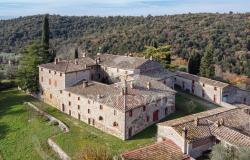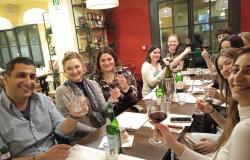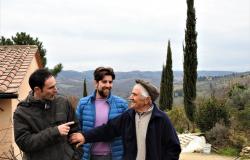The first time I saw the strange landscape of Le Balze was from a train speeding between Arezzo and Florence. The InterCity Express leaves the roads behind, zooms through tunnels, crosses the Arno River and whizzes across valleys seemingly untouched by civilization.
Between the tracks and the vast Prato Magno mountain range is a heavily eroded terrain of pinnacles and ravines sculpted of bare earth and rock. Here and there a small valley reveals a field for grazing sheep, a vineyard and an abandoned farmhouse. The landscape looks as if it has remained wild and unchanged for centuries.
The stratified canyons have a strange, ‘otherworldly’ beauty that captured the powerful intellect of Leonardo da Vinci, more than 500 years ago.
Ancient landscape

While studying the upper Arno River, Leonardo observed that a lake had been formed, ‘which was shut in at about where now we see Girone, and it filled the valley above for a distance of forty miles. This valley received upon its base all the soil seen at its maximum height at the foot of the Prato Magno for there the rivers have not worn it away. Across this land may be seen the deep cuts of the rivers which have passed there in their descent from the great mountain of Prato Magno.’*
Today it is possible to retrace Leonardo’s steps and observe the area still much as it was, experiencing the same sensations.
As he had correctly observed, water was the defining force of Le Balze.
Approximately two million years ago, it was a great lake gradually filling with sediments dislodged from the vast mountain range above it. As the lake floor was exposed, ravines were carved into the sediments, creating spires and pinnacles of sand, lime and pebbles. Eons of continual erosion by wind and water of the earth, baked dry in the hard sunlight, have created great peaks that soar above the precious cultivated valleys, stratified cathedrals now tower over streams, oak woods and pathways in a kaleidoscope of oranges, greys and ochres.
Of the Master’s great works, his unusual departure in landscapes can be seen most clearly in the two paintings of the Virgin of the Rocks in The Louvre in Paris and in the National Gallery in London.
Your itinerary

To get to Le Blaze, exit the A1 at Valdarno and drive toward Terranuova Bracciolini and on to Loro Ciuffenna where you head northwest along the ancient Cassia Vetus, now the ‘Setteponte’ Road. On the very edge of the Pratomagno itself, you will want to stop and take in the glorious views as the road winds and curves past olive groves and primeval terraces.
At the tiny town of Piantravigne you have a splendid panorama of the terrain. Continue on to the village of Pian di Scò where the ancient parish Church of S. Maria still boasts its medieval roof and stone columns.
Retracing the road you return to Castelfranco di Sopra and visit the Abbey of S. Salvatore a Soffena. The ancient walled town of Castelfranco was founded in the last years of the 13th century and probably planned by Arnolfo di Cambio.
From here, head south where the road plunges into the valley and you weave in and out of the ravines. After about five minutes you can take a white road, left, heading toward Le Balze Agriturismo and see the fantastic formations rising around you.
This area is a marvellous place for cyclists, walkers and those interested in the fossils to spend some time as the zone is considered an extremely important fossil deposit from a time when the lake and valley were populated with animals and plants similar to those of the modern-day tropical regions. Many of these finds are now displayed at the Palaeontological Museum of Montevarchi.
Change of scene

Along the original starting point at the Setteponte Road, in the direction of Arezzo, you will finally cross the Arno further upstream at a magnificent Romanesque bridge.
Whereas Le Balze was arid, you now have the contrasting wetlands and wooded glens that make up the nature reserves of the Valle dell’Inferno e Bandella and of Ponte a Buriano and Penna.
Leonardo wrote extensively about rivers. His existing codices contain detailed analyses of currents, depths, surfaces, ripples and the surrounding landscapes. He also gives a delightful description of an arch as ‘nothing else than a strength caused by two weaknesses; for the arch in buildings is made up of two segments of a circle and each of these segments being in itself very weak desires to fall and as one withstands the downfall of the other, the two weaknesses are converted into a single strength.’*
What better place to combine his two great interests than at Ponte Buriano? A Nature Reserve since the 1950s, the area extends for about seven kilometres along the course of the river Arno, from the bridge to the artificial reservoir below a dam at Penna.
In 1502, while Leonardo was working for Duke Cesare Borgia as his military architect, he mapped the area extensively and would have taken particular interest in the bridge and its ramparts, which even then had withstood the most terrible of floods. The bridge, built in 1277, has seven elegant arches and so inspired Leonardo that he painted it in the background of his most acclaimed portrait, the Mona Lisa.
You can view the landscape of downy oaks, shrub bushes, reeds and agricultural fields much as Leonardo did. The marsh and lake areas have created an unusual morphology that contributes to a wide variety of flora and fauna.
Nesting waterfowl include species that are both rare and endangered, but footpaths take visitors over hills and though wooded areas that cover 1199 hectares of pristine beauty, the combined efforts of man and nature. Over centuries, this has become a unique wilderness experience where artistic, historical and natural beauty abounds.
*extracts from The Notebooks of Leonardo da Vinci.
Further information
- The official tourism site for the area has an itinerary for the Setteponte Road that follows the area in this article.
- The site for protected areas within the province can be found here.
- There is a visitors centre at Ponte a Buriano that is generally open on Saturdays and Sundays, around Easter and most public holidays.













